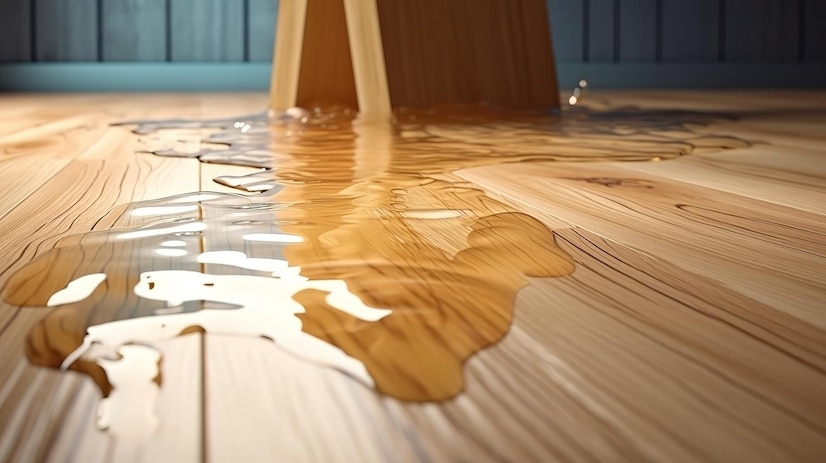Have you ever had the problem of water damaging your wooden furniture, making it swollen and unsightly? If you have, you know how frustrating it can be. But don’t worry; you’re not alone. Many face This common issue, whether from a spill, leak, or flood. Fortunately, there is a way to fix it. This guide will walk you through the steps to restore your wooden furniture to its former glory. We’ll cover everything from assessing the damage to refinishing. So, let’s get started!
What Happens When Wood Gets Wet?
It’s important to know how water damage affects wood furniture before trying to fix it. Wood is absorbent, so when it gets wet, it can swell, warp, and change color. This happens because the water changes the natural structure of the wood. To fix water-damaged wood furniture, you need to understand how bad the damage is and then follow some steps to restore it.

Assessing the Damage
Step 1: Remove the Furniture from Moisture Source
Before diving into the assessment, your priority is to ensure that the water-damaged furniture is no longer in contact with moisture. This step is crucial because keeping the furniture wet only exacerbates the damage. Remove the furniture from the source of moisture, whether it’s a leak, spill, or flood. Place it in a dry and well-ventilated area, ideally in a space with controlled humidity.
Step 2: Examine the Swelling
Careful inspection of the furniture for swelling is the next step. Swelling typically manifests as areas where the wood has expanded or buckled due to water absorption. Look closely at the affected areas, including tabletops, legs, or other wooden surfaces. Use your fingers to press on the wood gently; if it feels spongy or gives in to pressure, that’s a sign of swelling. Also, visually inspect the wood for any noticeable changes in shape or texture.
Step 3: Check for Mold and Mildew
Water damage often creates a conducive environment for mold and mildew growth. These can be not only unsightly but also hazardous to your health. Examine the affected areas for any signs of mold or mildew. Look for black or greenish spots, fuzzy growth, or a musty odor. Mold and mildew can appear on the surface or even within the wood if the damage is extensive. If you notice any of these signs, it’s critical to address mold and mildew promptly.
Step 4: Document the Damage
Documenting the damage is a prudent step that can be invaluable, especially if you’re considering professional assistance. Take clear photographs of the water-damaged furniture from various angles. Ensure that the images capture the extent of the damage, including any visible swelling, warping, or mold growth. These photographs can serve as evidence and reference points when discussing the repair process with professionals or seeking expert advice.
Assessment is the foundation of effective restoration. Once thoroughly assessing the damage, you’ll be better equipped to determine the appropriate action. Depending on the severity of the damage, you can then decide whether you can address it through DIY solutions or if it’s necessary to engage a professional restoration service.
DIY Solutions for Minor Damage
If you’re dealing with minor water damage that’s confined to a small area of your wooden furniture, you can attempt to address it yourself with the following DIY solutions:

Drying the Wood
When dealing with minor water damage, the primary goal is to dry the affected wood thoroughly. Moisture is the root cause of swelling and warping, so removing it is essential to prevent further damage.
- Natural Drying: Place the water-damaged furniture in a dry, well-ventilated area. Ensure there’s good airflow around the piece. Natural drying can take time, so be patient. You can also open windows and use fans to increase air circulation around the furniture to expedite the process. Fans help in evaporating the moisture trapped within the wood.
- Dehumidifiers: Using a dehumidifier in the room where the furniture is located can significantly aid in dying. Dehumidifiers help by extracting excess moisture from the air, which, in turn, accelerates the drying of the wood. Remember to empty the dehumidifier’s reservoir regularly to maintain its effectiveness.
Removing Mold and Mildew
Addressing mold and mildew promptly is essential, as these growths can damage the wood and pose health risks. Here are three DIY methods to deal with mold and mildew:
- White Vinegar Solution: Mix equal water and white vinegar to create a mild, effective cleaning solution. Gently scrub the affected area with this solution using a soft cloth or sponge. Ensure you wear gloves and a mask for protection. After scrubbing, clean the area with a damp cloth to remove any residue. White vinegar is known for its mold-fighting properties and can help eliminate the musty odor.
- Hydrogen Peroxide Solution: Mix some water and hydrogen peroxide together to get rid of stubborn mold or mildew. Apply this solution to the affected area, let it sit for a few minutes to loosen up the growth, and gently scrub it. After that, rinse the area thoroughly with water and dry it. Hydrogen peroxide is a good disinfectant and can help remove mold.
- Baking Soda Paste: To get rid of mold or mildew, you can make a paste by mixing baking soda with water until it’s thick. Apply the paste to the affected area and gently scrub it with a soft brush or sponge. Baking soda can help remove the mold and neutralize any bad smells. After cleaning, rinse the area and let it dry.
Remember that mold and mildew can be harmful, so always wear protective gear when dealing with them, including gloves and a mask. Properly ventilate the area during and after cleaning to ensure any residual moisture dissipates.
Repairing Minor Warping
When you encounter minor warping in your wooden furniture, you can often correct it without professional assistance by following these steps:
Moisten and Press:
- Lightly dampen a cloth with water, ensuring it’s not soaking wet but damp enough to be effective.
- Place the damp cloth over the warped area of the wood.
- To help the wood regain shape, put a weight or heavy object on top of the cloth. The weight should apply even pressure across the warped section.
- Leave the setup undisturbed until the wood has dried and regained its original shape. This process may take some time, so patience is key.
Heat and Pressure:
- Set clothes iron to a low setting, ensuring it’s not too hot to avoid damaging the wood.
- Place a damp cloth between the iron and the warped area of the wood.
- Apply gentle pressure with the iron as you move it slowly over the warped section.
- The heat and pressure help the wood gradually return to its original shape.
- Continue this process until you notice an improvement in the wrapping.
When to Call in a Professional
While minor water damage can often be addressed through DIY methods, there are situations where seeking professional assistance is necessary to ensure the safety and effectiveness of the restoration process. Here are some signs that indicate it’s time to call in a professional:
Extensive Swelling and Warping
Professional intervention is required if a significant portion of your furniture is severely swollen or warped. Large-scale warping can be challenging to correct without specialized equipment and expertise.
Structural Damage
If the water damage has compromised the structural integrity of the furniture, it’s not safe to attempt repairs on your own. Structural damage can affect the stability and safety of the piece, making professional assessment and restoration essential.
Mold Infestation
When mold has spread extensively, especially on the interior of the furniture, it requires specialized treatment and expertise to ensure complete removal. Mold can harm your health and the wood, so professional mold remediation is crucial.
Valuable or Antique Furniture
If the damaged piece holds significant monetary or sentimental value, it’s best to entrust it to a professional specializing in restoring antique or valuable wood items. DIY methods may inadvertently devalue or further damage such pieces.
In conclusion, water damage to wooden furniture can be disheartening, but with the right knowledge and approach, you can restore your cherished pieces to their former glory. Remember to assess the damage carefully, and don’t hesitate to seek professional assistance. By following the steps outlined in this guide and taking preventive measures in the future, you can ensure your wood furniture remains beautiful and functional for years to come.


